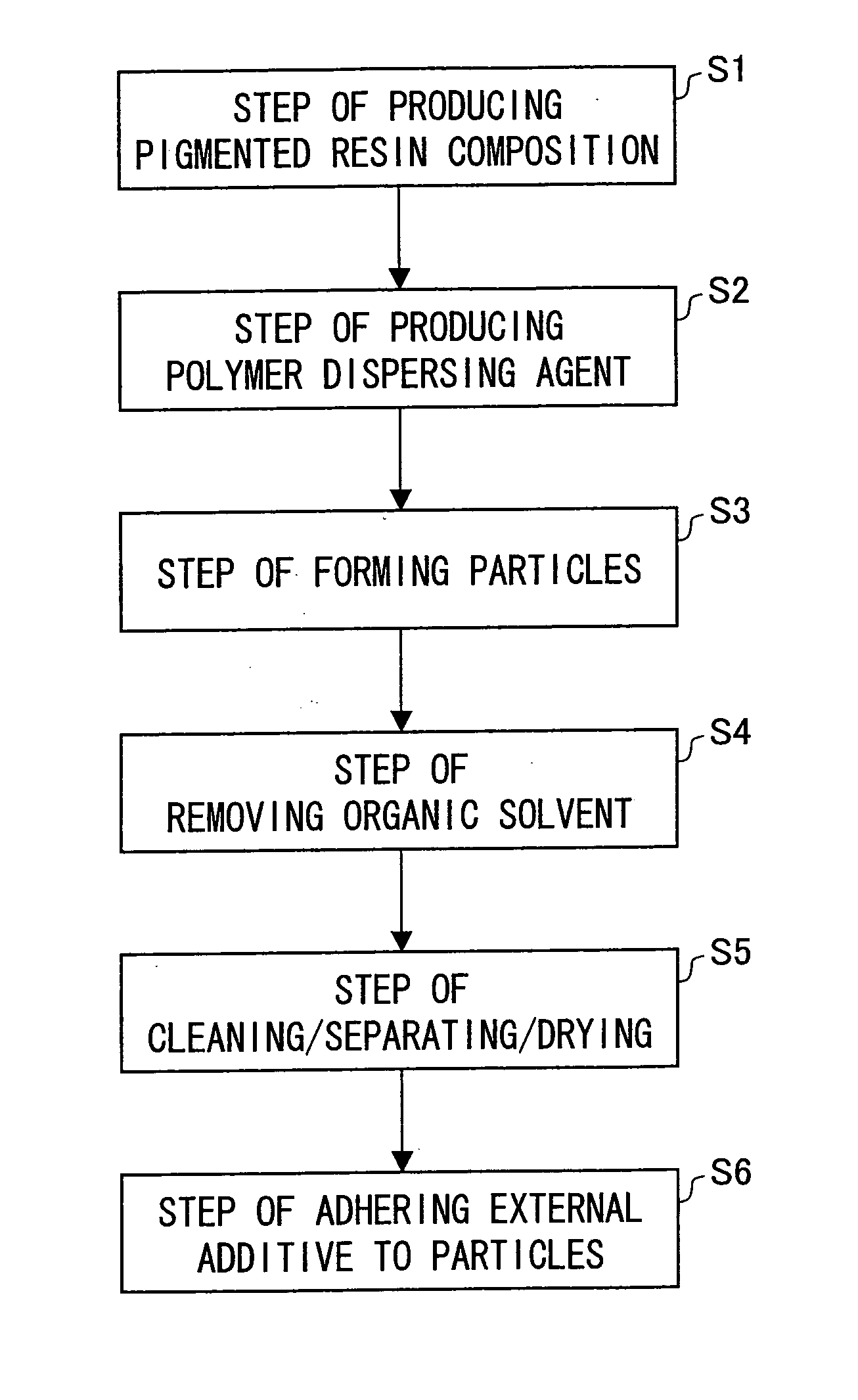Toner for development and method of producing toner
a technology of toner and development, applied in the field of toner production method, can solve the problems of increasing the cost of producing toner, reducing the amount of produced toner, and difficult to produce toner with a volume average particle diameter of 6 m, and achieves the effects of small particle size, excellent humidity resistance, and easy downsizing of toner particles
- Summary
- Abstract
- Description
- Claims
- Application Information
AI Technical Summary
Benefits of technology
Problems solved by technology
Method used
Image
Examples
example 1
1)>>
[0090] One hundred parts of polyester resin (glass transition point (Tg) of 62° C., softening point of 130° C.), 5 parts of coloring agent (carbon black), and 5 parts of wax (polyethylene, melting point of 125° C.) were mixed and dispersed for three minutes by using a Henschel mixer. Thereafter, the mixture was melted, kneaded, and dispersed by using an extruder (product name: “niidikusu” MOS 140-800, manufactured by Mitsui mining Co., Ltd.). As a result, a pigmented resin extrudate was prepared (the product will be referred to as a pigmented resin extrudate).
[0091] The softening point was measured under the conditions mentioned below by using a flow-tester CFT-500 (manufactured by Shimadzu corporation). A temperature at a time of ½ stroke was measured as the softening point.
[Conditions of Measurement of Softening Point]
[0092] Amount of sample: 1 g
[0093] Dimension of die: 1.0×1.0 mm
[0094] Load of extrusion: 1960 kPa (20 kgf / cm2)
[0095] Temperature elevation rate: 6° C.
[009...
example 2
[0105] Polymer dispersing agent solution (Q) was prepared by the method described below, in place of polymer dispersing agent solution (P) used in Example 1.
[0106] A long chain macromonomer solution was prepared by following the same method as in Example 1. While the long chain macromonomer was maintained at 95° C., a mixture of 60 parts of styrene (ST), 10 parts of methacrylic acid (MAA), 3 parts of normalbutylacrylate (NBA), 17 parts of laurylmethacrylate (LMA), 10 parts of hydroxyethylmethacrylate (HEMA), 1.0 parts of “kayaesuteru O” (t-butylperoxy2-ethylhexanoate, manufactured by Nippon kayaku Co., Ltd.), and 1.0 parts of “tokusorubento” was dropped over three hours. Then, this was maintained at the same temperature for one hour. Thereafter, a solution containing 0.25 parts of “kayaesuteru O” and 2.33 parts of “tokusorubento” was dropped over 30 minutes. This was maintained at the same temperature for 1.5 hours, and then cooled. As a result, polymer dispersing agent solution (Q...
example 3
[0109] Polymer dispersing agent solution (R) was prepared by the method below, in place of polymer dispersing agent solution (P) used in Example 1.
[0110] A long chain macromonomer solution was prepared by following the same method as in Example 1. While the long chain macromonomer solution was maintained at 95° C., a mixture of 60 parts of styrene (ST), 10 parts of methacrylic acid (MAA), 30 parts of laurylmethacrylate (LMA), 1.0 parts of “kayaesuteru O” (t-butylperoxy2-ethylhexanoate, manufacture by Nippon kayaku Co., Ltd.), and 1.0 parts of “tokusorubento” was dropped over three hours. Then, this was maintained at the same temperature for one hour. Thereafter, a solution containing 0.25 parts of “kayaesuteru O” and 2.33 parts of “tokusorubento” was dropped over 30 minutes. Then, this was maintained at the same temperature for 1.5 hours, and then cooled. As a result, polymer dispersing agent solution (R) was obtained. Details of polymer dispersing agent solution (R) were as follow...
PUM
| Property | Measurement | Unit |
|---|---|---|
| Temperature | aaaaa | aaaaa |
| Temperature | aaaaa | aaaaa |
| Glass transition temperature | aaaaa | aaaaa |
Abstract
Description
Claims
Application Information
 Login to View More
Login to View More - R&D
- Intellectual Property
- Life Sciences
- Materials
- Tech Scout
- Unparalleled Data Quality
- Higher Quality Content
- 60% Fewer Hallucinations
Browse by: Latest US Patents, China's latest patents, Technical Efficacy Thesaurus, Application Domain, Technology Topic, Popular Technical Reports.
© 2025 PatSnap. All rights reserved.Legal|Privacy policy|Modern Slavery Act Transparency Statement|Sitemap|About US| Contact US: help@patsnap.com


